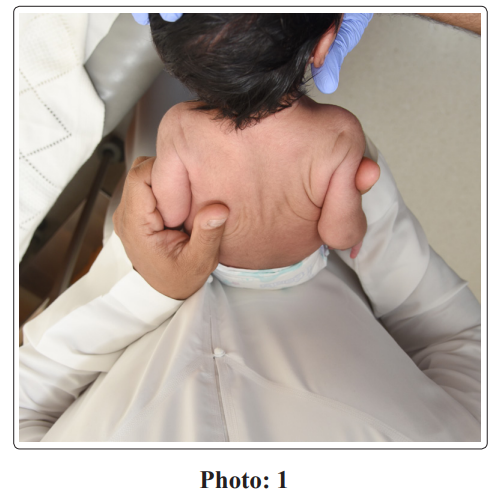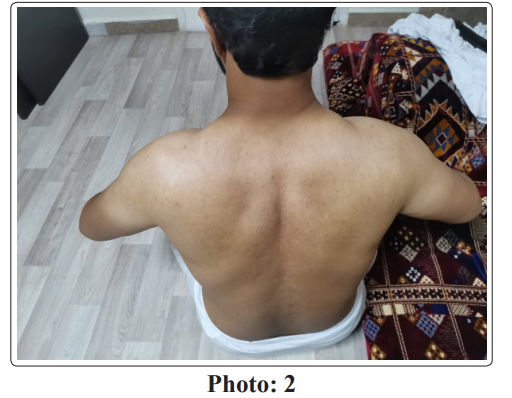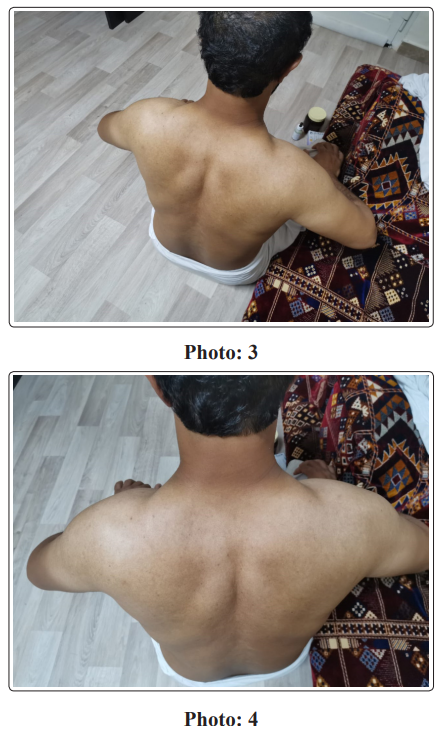Author(s): <p>Amin N A Soofi</p>
Congenital Acromial or Shoulder dimples are cutaneous depressions overlying the acromial process of the scapula. They are usually bilateral and symmetrical. Isolated biacromial dimples are usually benign and warrant no further investigations. Family history in an autosomal dominant pattern, as in our case, is frequently obtainable but the majority of isolated bilateral shoulder dimples are sporadic. There are few reports of syndromic associations as well as two cases of associated maternal cocaine abuse.
Our case is a term female neonate who was noted on routine new-born check to have bilateral symmetrical shoulder dimples. She was otherwise healthy, had normal range of shoulder movements and was not dysmorphic. On further assessment it transpired the father has the same bilateral shoulder dimples but was not aware of their existence. No further investigations were carried out. This case add to the few reported cases of Biacromial Dimples with autosomal pattern of inheritance in an otherwise normal baby
A one day old female neonate was admitted to our NICU in view of hypoglycaemia which responded to intravenous dextrose and progressive feeding advancement. Bilateral shoulder dimples (Figure 1) were noted by the nursing staff during routine care. The baby was a fruit of normal vaginal delivery, at 39+ weeks, following an uncomplicated pregnancy. She was the firstborn child to Arabic parents who are first degree cousins.

The dimples were noted as bilateral symmetrical deep cutaneous depressions below each acromion. They were positioned over the posteromedial deltoid. Each dimple was 1.5 mm deep. The skin textures over the dimples was different in texture to the surrounding skin, resembling nevus sebaceous of Jadassohn. There was no discoloration, pigmentation or other skin changes around the dimples. One Café Au Lait spot was noted over the right thigh. There was no restriction in the range of movement at the shoulder joint. There was no cleft palate, megalocephaly or dysmorphic features. The rest of the examination was normal. The baby’s father (Figure 2) was examined and noted to have similar bilateral acromial dimples without any complication. The father had no prior knowledge of their existence.


Biacromial Dimples are rarely reported in neonatal or paediatric literature. Extensive search through PubMed including Medline, using the terms bilateral Shoulder Dimples and bilateral Acromial Dimples revealed only 3 published case reports from 1987-2020. A similar search through the National Library of Medicine (NLM) from 1843-2020 using various relevant combinations did not yield any article. Internet search using Google through medical paper’s publications revealed less than 10 published articles over the last 40 years. The papers were mostly edited by dermatologists. We could not find any paper by a neonatologist and only one paper by a paediatrician [1].
Review of the literature suggests the majority of cases are benign with no adverse developmental association or mechanical sequelae. The majority of reported cases were sporadic [2]. There were few case reports of an autosomal dominant inheritance pattern [3, 4]. This is also validated in our patient. However the paper with the most reported cases, which included seven patients, found family history in only one case [5]. The proposed theory of the aetiology of the Biacromial dimples due to the entrapment of skin between the shoulder bones and wall of the uterus is not plausible by the virtue of their symmetry and the familial occurrence [6].
Associations of Biacromial dimples as part of more complex syndromes should not be overlooked. They have been reported as part of malformation syndromes such as 18q deletion syndrome where it is virtually a consistent feature [7]. Furthermore they have been noted in skeletal dysplasia such as Apert’s syndrome (Acrocephalosyndactyly type I, MIM #101200) [8]. Cleft palate, macrotia and or microcephaly may point toward Say syndrome which has been described as a further association [9].
Joanna Debosz’s and Richard M Haber described a case with associated maternal cocaine abuse. This was reported earlier only once [10, 11].
Anton Von Raebrox et al described an association between biacromial dimples and future recurrent posterior dislocation of the shoulder occurring in late teenage years [12]. There are no other reports of associated adverse effects.
Biacromial skin dimples appears to be benign in the majority of reported cases and should be considered as a normal anatomic developmental variation. However, the neonatologists and the paediatricians should be aware of this unusual finding and the potential of syndromic association. Investigations in isolated Biacromial Dimples are not warranted and parental assurance is justified.
1.A Newborn with Bilateral Shoulder Dimples: Case Report and a Review of Literature. Abstract published at Hospital Medicine 2014, March 24-27, Las Vegas, Nev.. Abstract 284 Journal of Hospital Medicine, V-9.
2.Virgili A, Tosti G, Bettoli V, Corazza M (2002) Multiple Congenital Symmetric Skin Dimples. Dermatology 2002; 204: 293-295.
3.Wit MA, Kamps A (2011) An infant with dimples on both shoulders. BMJ Case Rep. 2011: bcr0920114769.
4.Beillard C, Guillet G, Vabres P, Dagregorio G, Larregue M (2005) Bi-acromial dimples: a series of seven cases. Pediatr Dermatol. 22: 412-414.
5.Debosz J, Haber RM (2014) Bilateral acromial dimples: a case report and review of the literature. Pediatr Dermatol. 31: 363-367.
6.Liu AJ, Nanan R (2008) Bi-acromial dimples. Int J Dermatol. 2008;47(6):594-595.
7.Von Raebrox A, Campbell B, Ramesh R, Bunker T (2006) The association of sub acromial dimples with recurrent posterior dislocation of the shoulder. J Shoulder Elbow Surg. 15:591- 593.
8.Kosif Rengin (2015) Anatomical Skin Dimples. Innovative Journal of Medical and Health Science, 5: 15-18.
9.Say B, Barber D H, Hobbs J, Coldwell J G (1975) A new dominantly inherited syndrome of cleft palate. Humangenetik 26: 267-269.
10.Debosz J, Haber RM (2014) Bilateral acromial dimples: a case report and review of the literature. Pediatr Dermatol. 31: 363-367.
11.Debosz J, Haber RM (2014) Bilateral acromial dimples: a case report and review of the literature. Pediatr Dermatol. 31: 363-367.
12.Anton Von Raebrox (2006) The association of sub acromial dimples with recurrent posterior dislocation of the shoulder, Journal of shoulder and elbow surgery / American Shoulder and Elbow Surgeons. 15: 591-3.
View PDF